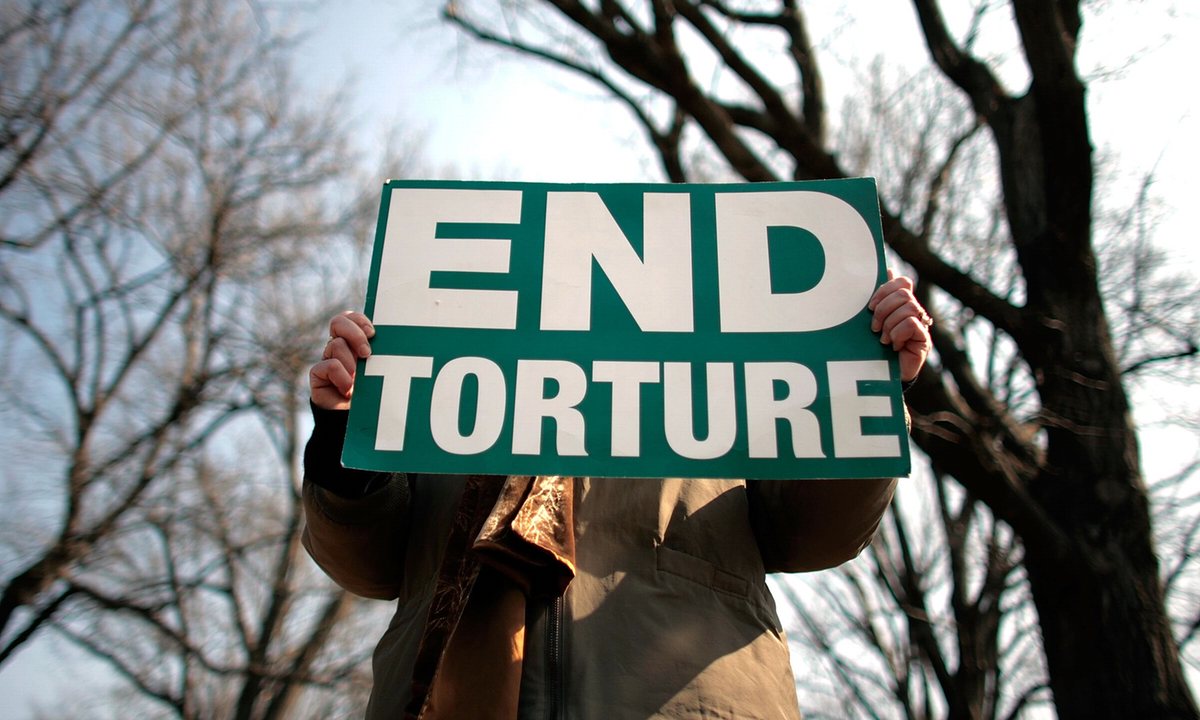CIA medical staff gave specifications on how to torture post-9/11 detainees

Office of Medical Staff detailed exactly how to enforce sleep deprivation, limit food intake, waterboard and use confinement boxes, declassified report revealed

CIA medical personnel acknowledged that placing detainees in small boxes barely large enough to fit their bodies inside was not particularly effective, but they still provided guidance permitting interrogators to continue using the so-called confinement boxes for hours on end.
Sensitive agency documents, declassified on Tuesday, provide a new level of detail on the intimate involvement of its medical staff during its post-9/11 torture program. Officials assigned to the Office of Medical Staff (OMS) provided precise specifications for enforcing sleep deprivation, limiting the caloric intake of detainees food, and the proper positions for waterboarding, as outlined in a 2004 document providing guidelines on medical and psychological support for torture.
In the event that a detainee stopped eating inside the agency’s unacknowledged prisons overseas, known as black sites, OMS advised that the preferred method to forcibly feed a detainee was rectally a procedure that human-rights advocates have equated to sexual assault.
Since a 2014 Senate report criticized the CIA for running what it characterized as an ineffective, brutal regimen of incommunicado confinement, the agency has pointed to the involvement of OMS staff to claim it performed its torture within doctor-mandated safeguards. Yet human-rights-minded physicians say OMS staff violated a fundamental obligation of medical ethics to do no harm and instead provided agency torturers with a physiologically informed blueprint for inflicting pain.
The guidelines are an affront to my profession, the medical and mental-health professions, and health professionals should know better and be ashamed of defending a document like this, said Vincent Iacopino, the medical director of Physicians for Human Rights.
Among the procedures discussed in the 2004 document, is a method for placing detainees in what it termed awkward boxes. The technique, first proposed by contractor psychologists James Mitchell and Bruce Jessen, is known as the confinement box and was dramatized in the movie Zero Dark Thirty.
Some boxes were small cubes allowing little more than a cross-legged sitting position, the OMS document advised. Agency torturers were permitted to place detainees into those for up to two hours consecutively, [a]ssuming no significant medical conditions (e.g., cardiovascular, musculoskeletal) were present. Longer boxes, rectangular and just over the detainees height, not much wider than his body, and comparatively shallow, could hold detainees for eight consecutive hours, up to a total of 18 hours a day.
Abu Zubaydah, whose 2002 detention became the pilot program for CIA torture, spent a cumulative 266 hours, equivalent to more than 11 days, within the longer box, which the Senate report noted was reminiscent of a coffin. His smaller box was 21 inches wide, 2.5ft high and 2.5ft deep. Agency officials placed him in it for a total of 29 hours. That confinement occurred with the span of an aggressive 20 day-span, according to the Senate report.
The CIA interrogators told Abu Zubaydah that the only way he would leave the facility was in the coffin-shaped confinement box, the Senate report noted.
A different OMS document, also declassified on Tuesday, concluded that Abu Zubaydah likely would have cooperated with interrogators without being waterboarded. CIA interrogators subjected Abu Zubaydah to waterboarding, a technique the body processes as drowning-induced suffocation, 83 times in the span of a month.
Yet the OMS personnel providing the guidelines took a dim view of the intelligence value of the confinement boxes.
These have not proved particularly effective, as they may become a safe haven offering a respite from interrogation, the medical staff document states.
Additionally, the Geneva Conventions bar close confinement for prisoners of war a classification the Bush administration denied CIA detainees except where necessary to safeguard their health.
Elsewhere in the document, the medical staff advises CIA interrogators on medically acceptable procedures for various torture techniques, including prolonged stress positions, severe dietary restrictions and waterboarding.
Detainees without medical contraindications can be kept in shackled stress positions for extended periods (up to 48 hours) in a standing position if the hands are no higher than head level and weight is borne by the lower extremities. Keeping detainees standing, however, will yield dependent edema, the accumulation of fluid in the lower extremities; the document instructs that regular attention to leg circumference and the fit of shackles is mandatory.
OMS instructed that the CIA could, for shorter periods of time, inflict more stressful shackled positions, through shackling someones arms above the head (elbows not locked) for roughly two hours without great concern. Keeping the detainee in such a position for between two and four hours would merit caution, and subject should be monitored for excessive distress, the document states.
Making reference to common dieting plans, OMS recommended a minimum intake of 1,500 Kcalories/day, recognizing that intakes of 1,000 kcal/day are safe and sustainable for weeks on end. Should a detainee engage in a hunger strike and cease drinking fluids, OMSs preferred option of forcibly feeding detainees was rectal tube insertion, ahead of intravenous methods.
[B]ecause it is less invasive as a medical procedure, the rectal tube is considered by OMS the first line intervention, the document reads.
One detainee, a German man named Khalid el-Masri whom the CIA held in 2004 by mistake, lost 50lb during five months of black-site captivity, according to a different declassified document.
The document writes that waterboarding is by far the most traumatic of the enhanced interrogation techniques. It runs through a checklist of pre-existing medical concerns that would prevent waterboard use, and warns the process can induce pneumonia or even death.
OMS instructed interrogators on how to revive suffocated detainees a sub-xyphoid thrust and urges aggressive medical intervention should such first aid fail. Cumulative effects of extended waterboarding sessions, defined as days 3-5 of an aggressive program, are a potential concern, and states that beyond this point continued intense waterboard applications may not be medically appropriate.
Although the CIA is barred from conducting human experimentation, OMS instructed that every application of the waterboard be thoroughly documented, in order to best inform future medical judgments and recommendations.
The CIA documents, which informed the Senate torture report, were released in response to transparency lawsuits brought by the ACLU and Vice News.
This is a manual for health professionals to aid and abet torture practices, and assuage peoples moral resistance to such acts, said Physicians for Human Rights Iacopino, himself a physician.
There’s a huge body of literature saying all these things are torture and ill-treatment. They cause lasting physical and mental pain. Any physician should know better.